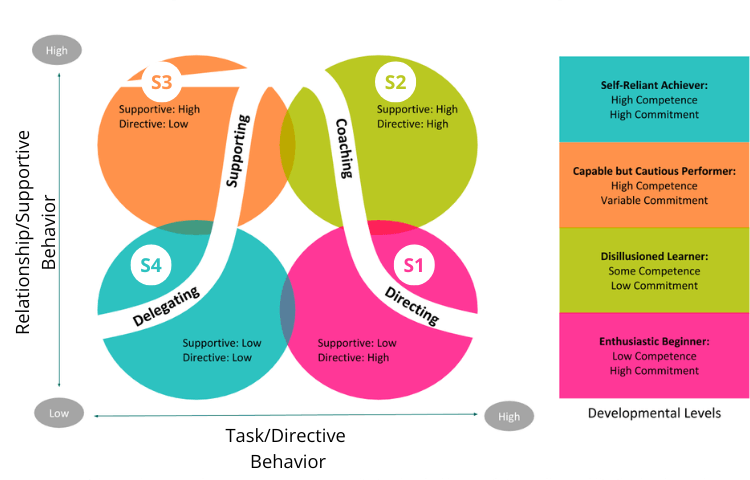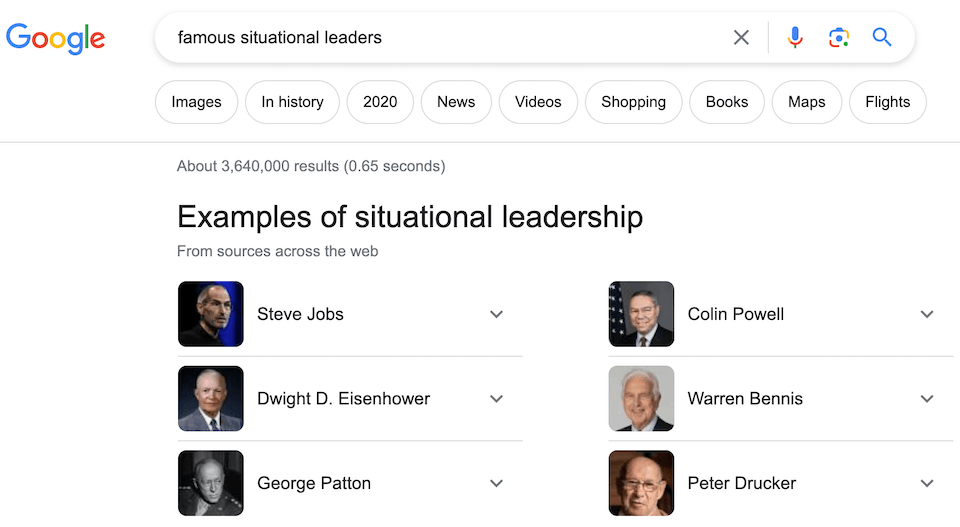Situational Leadership: 4 Styles of Hersey and Blanchard
Situational leadership is a leadership model developed by Hersey and Blanchard in 1969. The situational leadership model proposes adapting 4 types of different leadership styles depending on situations or tasks. We’ve examined the 4 styles of Hersey and Blanchard’s situational leadership model, advantages, disadvantages, when to use this model, and famous leaders applying situational leadership.
In this article
📌 Hint: Do not skip this article, you will find FREE Leadership Training resources throughout the article.
💡 You might be interested in the 21 Leadership Skills Professionals Expect to See in the Workplace article.
Hersey and Blanchard Situational Leadership
The inception of the model dates back to 1969. Situational Leadership Theory, now named the Situational Leadership Model, is a model created by Dr. Paul Hersey and Dr. Ken Blanchard when they were working on their phenomenal leadership book, Management of Organizational Behavior.
Hersey and Blanchard formulated the leadership style in two axes: task behavior and relationship behavior. They measure leaders’ characters on two axes by two different behaviors: supportive behavior and directive behavior.
Enhance Your Leadership Skills – Executive Leadership Training Program
San Francisco Business School offers an online, self-paced comprehensive executive leadership training program. You can consider enrolling in this program to improve your leadership skills.
4 Types of Situational Leadership Behaviors
Situational leadership proposes that leaders apply one of the four different types of leadership in every situation or task they face.
A Situational Leader employs one of four leadership styles that provide him or her with the highest probability of success in every situation they encounter. Those situations are a function of the task that needs to be performed, in conjunction with the task-related ability and willingness of the follower identified to perform it.
A Situational leader assesses the situation and how he can affect the follower or the performer of the task and applies one of the four styles. Hersey and Blanchard categorized these styles operationally as Task/Directive Behavior and Relationship/Supportive Behavior. You can see the four types of leadership behaviors in the following figure.

What are S1, S2, S3, S4 in Situational Leadership?
When Hersey and Blanchard analyzed the leadership behaviors, they divided this group into four quadrants and named each quadrant as S1, S2, S3, and S4. Let’s go through each of these four situational leadership behaviors.
S1: Directing (Telling, Directing or Guiding)
In the S1 quadrant, supportive behavior is low, and directive behavior is high. The main goal of the leader is to complete the tasks on time. To ensure this, leadership directs the follower or team member with his/her experience. Typically, communication is one way, from the leader to the member or follower. The leader does not expect new ideas or participation in decision-making. The leader’s main focus is the timely completion of the task for this leadership behavior.
S1, style 1 is generally used to create an ignition and for a short time. Typically used if there is a time pressure, emergency, or if the team members or followers do not have enough experience. The leader follows the members closely to make sure there is progress.
S1 style situational leadership behavior is similar to authoritative leadership or bureaucratic leadership models.
S2: Coaching (Selling, Coaching, or Explaining)
In the S2 quadrant, both supportive and directive behavior is high. The purpose of the leader is as same as in S1, timely completion of the tasks. However, in S2 situational leadership behavior, the leader discusses with the followers the importance of the tasks, and why they are doing it and accepts the participation of the group or followers although the final words are made by the leader. The leader is interested in the follower’s learning and gaining task-related experience as well.
S1, style 2 is generally used to get team buy-in. If the morale and motivation of the members are crucial to the task’s success, leaders can opt for S2 behavior. The leader closely follows the members when they are performing tasks, and organizes meetings to evaluate their performance, morale, and motivation.
S2 style situational leadership behavior is similar to the participative leadership model.
S3: Supporting (Participating, Facilitating, or Collaborating)
In the S3 quadrant, supportive behavior is high, and directive behavior is low. This situational leadership behavior of Hersey and Blanchard is fundamentally different from S1 and S2. In S1 and S2 behavior, the tasks are driven by the leader. However, in S3, the tasks are driven by the followers, and the leader just supports them when the followers need them. S3 behavior assumes that the followers are competent the perform the task, they just need motivation and support from the leader.
S3, style 3 is generally used to create alignment. In some cases, even though the resources are skilled and experienced to perform the task, they need some commitment or motivation. S3 situational leadership behavior can be applied in such cases.
S3 style situational leadership behavior is similar to the transactional leadership or servant leadership model.
S4: Delegating (Delegating, Empowering or Monitoring)
In the S4 quadrant, both supportive and directive behavior is low. In the s4 situational behavior of Hersey and Blanchard, members and followers are both competent and motivated to perform the tasks. They need minimum supervision and support from the leader.
S4, style 4 is generally used to create or enhance task mastery and autonomy. The followers are motivated, committed, and experienced enough to perform the tasks. The leader just shows the goal and sets the deadline. Followers perform the task with intrinsic motivation. The leader is comfortable that the task will be completed on time.
S4 style situational leadership behavior is similar to the laissez-faire leadership model.
Hersey and Blanchard Performance Readiness R1, R2, R3, R4 Levels
The situational leadership styles are most productive when aligned with the matching Performance Readiness levels of the performers. The model groups performance readiness into four:
- Unable and Insecure or Unwilling (R1): Inexperienced or developing members. S1 style of leadership fits this group.
- Unable but Confident or Willing (R2): They have some skills but are not at an adequate level. The S2 style of leadership fits this group.
- Able but Insecure or Unwilling (R3): These team members are competent, however, they are not motivated enough to perform the task. S3 style leadership fits this group.
- Able and Confident and Secure (R4): The members are highly skilled, confident, and motivated. S4 style leadership fits this group.
If you cannot align the leadership style to the performance readiness level of the group, you might observe demotivation, low morale, and underperformance.
Blake Mouton Grid focuses on different types of leadership based on concerns about results and people. You might be interested in checking that model as well.
Free Online Leadership Skills Training Program
One of the requirements to be a good leader is to improve yourself continuously. The best way to do this is, to enhance your competence through training. Take a step ahead and jumpstart your leadership competence. Enroll in our 1-hour Free Leadership Training program.
What are M1, M2, M3, and M4 in Situational Leadership of Hersey and Blanchard?
Hersey and Blanchard’s Situational Leadership model proposes that the right leadership behavior will depend on the person or group being led. When assessing the group, the leader checks the competence, experience, personal characteristics, motivation, and morale of the group or person. Based on these parameters, the situational leadership model categorizes groups into four: M1, M2, M3, and M4.
| High | Medium | Low | |
| M4 | M3 | M2 | M1 |
| High maturity | Medium maturity, higher skills but lacking confidence | Medium maturity, limited skills | Low maturity |
| Individuals can do the task on their own and are comfortable with their own ability to do it well. They are able and willing to not only do the task but to take responsibility for the task. | Individuals are ready and willing to do the task. They have the skills but are not confident in their abilities. | Individuals are willing to do the task but lack the skills to do it successfully. | Individuals lack the knowledge, skills, or confidence to work on their own, and they often are unwilling to take the task on. |
Maturity levels can be considered based on each task as well. Even if the resources are competent, confident, and motivated to do their job, you can consider them in M1 if you ask them to perform a specific task that they are not experienced in. For instance, an experienced software developer building programs in a particular programming language will be at the M1 level if you ask him to develop a program in another programming language.
💡 Read 15 Types of Leadership article to learn about other leadership styles.
What are the D1, D2, D3, and D4 in Situational Leadership?
After the inception of the Situational Leadership theory, Hersey and Blanchard evolved the theory independently. In 1985, Blanchard introduced Situational Leadership II (SLII) in the book “Leadership and the One Minute Manager: A Situational Approach to Managing People.”
In the SLII situational leadership model, Blanchard uses competence and commitment to categorize four levels of development. Competence refers to ability, knowledge, and skill. Commitment refers to confidence and motivation.
Ken Blanchard proposes that “Four combinations of competence and commitment make up what we call ‘development level.'” Blanchard’s four levels D1, D2, D3, and D4 are as follows:
- D1 – Enthusiastic Beginner: Low competence with high commitment
- D2 – Disillusioned Learner: Low/middling competence with low commitment
- D3 – Capable but Cautious Performer: High competence with low/variable commitment
- D4 – Self-reliant Achiever: High competence with high commitment
For the best performance, a leader needs to encourage followers with an approach fitting the style to the development level of the person.
- For the people at the D1 level, S1 situational leadership behavior will be suitable.
- For the people at the D2 level, S2 leadership behavior will be suitable.
- For the people at the D3 level, S3 behavior will be suitable.
- For the people at the D4 level, S4 behavior will be suitable.
Consider your leadership experience. Is it practical to treat everybody the same? A leader’s approach should be adaptable to the situations and development levels of the people.
Watch Laura’s 30 Seconds Experience – Executive Leadership Program
Hear from Our Alumni Laura Smith, Head of Design. Laura attended the Executive Leadership Program at SFBS.
Advantages of Situational Leadership of Hersey and Blanchard
There are several advantages of situational leadership. We will list the top three here.
1- Flexible
Unlike other leadership styles, situational leadership proposes a flexible approach that leaders can apply in different situations, different maturity levels, and performance levels. It does not have a “fit for all” style.
The people in a group have different motivations, different skills, and experiences. Hersey and Blanchard realize this and propose modular situational leadership behaviors for different cases.
2- Team Development
People are not the same, everyone needs a unique approach to their development. Because, personal characteristics, experience levels, and maturity are not the same. As the situational leader focuses on the individuals’ particular levels of maturity and performance, a tailored performance improvement plan is developed for each professional. This ensures better team development.
3- Adaptive to Change
As the situational leaders adapt themselves to each particular situation, this helps in the self-development of the leaders. Situational leadership creates new approaches for each case, and this improves the adaptability of the leader, group, and organization for unexpected situations.
Disadvantages of Situational Leadership
We’ve listed the top three disadvantages of situational leadership below.
1- Focuses on Short-Term Goals
Hersey and Blanchard’s situational leadership model focuses on short-term goals and even at a granular level, at the task level. This may cause seeing a bigger picture. For long-term goals and targets, situational leadership may not work.
2- Members May Perceive Favoritism
If the group is diverse in terms of experience and motivation, when the leader is applying different styles of situational leadership, some members may feel that the leader is favoring some members.
For instance, if there is an inexperienced junior team member (R1, D1, M1) in the team you will apply the S1: Directing style. Another team member is very experienced, working in the organization for several years, and is motivated to perform the tasks (R4, D4, M4). You will apply S4: Delegating style.
While you apply these two different styles, some members may think that you favor some members.
3- Might be Exhaustive for the Leader
Situational leadership focuses on each team member, maturity and motivation level. If the group is crowded, focusing on different people, assessing their performance and motivation, and choosing a tailored leadership style for them might be exhaustive for the situational leader.
When to Apply Situational Leadership of Hersey and Blanchard
Hersey and Blanchard developed the situational leadership model to focus on short-term goals and tasks. If there is a short-term project, with a few tasks to accomplish, you can apply this model.
Hersey and Blanchard did not dictate a group size to apply situational leadership. However, if the group is large, focusing on individuals will not be possible. We recommend applying situational leadership if there are fewer than seven members in your group.
If your group has different levels of experience, motivation, and maturity, you can apply situational leadership. This model will help you to assess the needs of each particular member and adapt a leadership style accordingly.
A Good Example of Situational Leadership – Marketing Project
To better illustrate situational leadership, we will explain it through a fictitious scenario.
Richard is working as a Marketing Project Manager in a prestigious marketing agency, MarketPro. Recently, his manager assigned him a new product launch marketing campaign. Richard will work with one of the company’s most valued clients, Pharma King, for two months to generate a powerful marketing campaign for a new vitamin supplement they are launching.
Richard has four team members, David, Lisa, Chris, and Jane. Each has different levels of experience, motivation, and maturity. Here is how Richard manages each member during this short-term marketing campaign.
David – Junior Marketing Analyst (R1, D1, M1)
David joined the team one month ago. He just graduated from university and he does not have enough experience to perform the tasks on his own. David has gone through some training programs and this project will be his first professional assignment. He is willing to take tasks but he is worried if he can perform on his own.
So, Richard applies the S1: Directing style of situational leadership for David.
Lisa – Creatives Professional (R2, D2, M2)
Lisa has two years of experience and MarketPro is her first job. She has worked on different marketing projects before however, this will be her first experience in a marketing campaign for a pharmaceutical company, so she has some hesitations although she is willing to take on new tasks.
So, Richard applies the S2: Coaching style of situational leadership for Lisa.
Chris – Senior Marketing Expert (R3, D3, M3)
Chris is a senior marketing expert with over 8 years of experience. MarketPro is his third job and he has been working here for more than three years. Chris worked on various projects, including launching pharma products as well. Chris was expecting a promotion in the last organization change, and he could not get it, so he is a little bit demotivated.
So, Richard applies S3: Supporting style of situational leadership for Chris.
Jane – Marketing Team Lead (R4, D4, M4)
Jane has over 10 years of experience in marketing. She has worked in reputable companies and joined Market Pro two years ago. Jane launched similar products for similar companies more than 10 times. Richard and Jane worked on various projects together and he knows that Jane has an “assigned me and consider it done” style. Jane earned a grade in the company this year and is considered a role model even from other functional departments.
So, Richard applies S4: Delegating style of situational leadership for Jane.
Famous Situational Leaders
There are several famous situational leaders. We’ve asked Google and received the following featured ones.

We will go through the top three famous situational leaders, Steve Jobs, Dwight Eisenhower, and Colin Powell.
Steve Jobs
Legendary Steve Jobs is an example of a situational leader. Do you remember the phenomenal product launches of Apple? He was not only launching products but also inspiring and motivating employees. Do you remember his following quote?
“It doesn’t make sense to hire smart people and then tell them what to do, We hire smart people so they can tell us what to do.”
Jobs wanted to hire the best people in areas he was not necessarily familiar with. This shows his delegating style of situational leadership.
Dwight D. Eisenhower
Dwight D. Eisenhower was the supreme Allied commander during World War II. He then became the President of the United States. He was adaptive to ever-changing conditions and situations with his situational leadership skills.
During the war, Eisenhower was reputable with his ability to balance “the interests and egos of a galaxy of generals and political leaders.” He was wandering around the troops, talking with soldiers, and boosting their motivation.
Collin Powell
Colin Luther Powell was an American politician, statesman, diplomat, and United States Army officer who was the 65th United States Secretary of State from 2001 to 2005. He was the first African-American secretary of state.
He says: “I am a situational leader, and I adjust my style, within limits, to the strengths and weaknesses of my subordinates”.
Powell admits that everybody is different, and the best leaders are the ones who can unleash the maximum potential of each individual.
Summary – Hersey and Blanchard Situational Leadership Model
Hersey and Blanchard developed the Situational Leadership theory in the 1970s. Since then, it has been widely adopted by several leaders focusing on short-term goals.
The situational leadership theory focuses on four different types of behaviors, Directing (S1), Coaching (S2), Supporting (S3), and Delegating (S4). The model supports different styles for different maturity and performance levels as well.
Situational leadership best works when there are different levels of experience and motivation in the group. Steve Jobs, Eisenhower, and Collin Powell are known as famous situational leaders.

